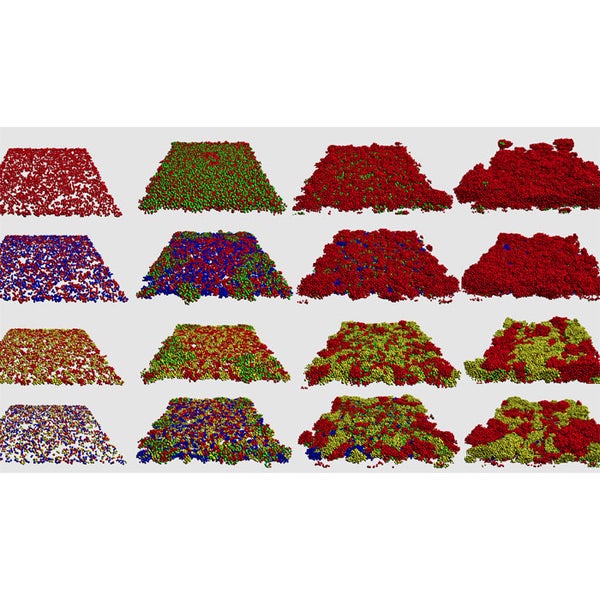Twitter’s hundreds of millions of users form communities that grow through the exchange of information, like-minded banter or biting criticism—sometimes all three. At its best, Twitter helped enable the Arab Spring revolutions that swept through North Africa and the Middle East beginning in 2010 to be broadcast to a global audience. Could a closer study of interactions among Twitter users likewise help put an end to antibacterial-resistant superbugs?
A team of Carnegie Mellon University (C.M.U.) researchers thinks so. They are using the microblogging service as a metaphor to better understand how different bacterial strains communicate with one another via certain chemical signals to form densely matted biofilms that protect them against antibiotics.
By better understanding how information propagates through networks of Twitter users, the researchers hope to ascertain the circumstances under which individual bacteria stop following their own independent routines and unite to create a biofilm blanket that covers them all. Comprehending the complex mathematics that govern these networks—whether they are found on Twitter or in the bacterial world—may help predict the chances for success of potential therapies that aim to interfere with bacterial communication and collaboration, according to C.M.U. College of Engineering professor Radu Marculescu, who is leading the effort.
On supporting science journalism
If you're enjoying this article, consider supporting our award-winning journalism by subscribing. By purchasing a subscription you are helping to ensure the future of impactful stories about the discoveries and ideas shaping our world today.
Marculescu and his collaborators grew and studied various bacterial specimens in order to learn how many bacteria had to bump up against one another and under what circumstances before they started to cooperate to build a biofilm. Then they created detailed software simulations of biofilm formation and development. Because these bacteria have essentially formed a "social network" to coordinate their behavior, build the biofilm and resist treatment, having such a quantitative model of their interactions is crucial for understanding how to fight them, he says.
Scientists have for years experimented with ways to break up these pathogenic parties by disrupting the signals that bacteria use for communication. Much of this research targets very specific conditions. But biofilms tend to consist of heterogeneous colonies that either compete for resources or collaborate to cause health problems for their host, says Marculescu, who will present his “molecular tweeting” research in early September at the Association for Computing Machinery’s ACM Conference on Bioinformatics, Computational Biology and Health Informatics in Atlanta. Bacteria communicate by exchanging signaling molecules, a process known as quorum sensing. The idea is to find out what’s behind the behavior of these pathogens and how it can be fought using antibiotics, quorum-sensing inhibitors or even probiotics, he adds.
Here is where the Twitter comparisons become relevant. To make their simulations more realistic the C.M.U. researchers created their computer models based on three different bacterial behaviors often found in clinical studies. One group of bacteria is known to create and pass along signaling molecules that get cells to generate substances used to form biofilms, a process the researchers liken to composing molecular tweets and retweets. A second group sends out its own signals but does not share the messages it receives—in other words, it doesn’t retweet. Instead, it hoards resources for its own growth. The third group neither tweets nor retweets—it eschews social media in favor of creating and using its own materials for biofilm growth.
Through the analysis of bacterial communication and biofilm formation, the researchers claim to have effectively revealed the underlying intercellular communication process and community organization within biofilms. Although the models still need broader experimental verification, the main benefit of such a discovery is that scientists could use this quantitative model of how diverse bacteria communicate as part of their own research into antibiotic resistance. “We are able to use concepts from network theory to describe the bacteria quorum-sensing network dynamics across the population and its contribution to virulence factors, biofilm formation and antibiotic resistance,” Marculescu says.
Taking this a step further, the research community could use the information about the intercellular network to identify the best approaches to quorum-sensing inhibition, which disrupts bacterial communication even if it does not actually kill the bacteria. “Once we have modeled their communications network, we can look at how bacteria behave under attack, how they communicate and how this communication breaks down,” Marculescu says. “Longer-term, with detailed [information] about a patient's condition, our framework can intelligently generate personalized treatment plans that have the best predicted efficacy without inducing drug resistance.” The researcher is presenting a second study at the 2nd ACM International Conference on Nanoscale Computing and Communication in Boston in late September that delves into the use of his team’s networking model to help control molecular communication in bacteria populations.
Marculescu’s work could be valuable as a theoretical framework that identifies the key parameters determining complex communication systems. Research focused on disrupting bacterial quorum sensing is typically quite specific in that any given study investigates a certain quorum-sensing system in a specific pathogen investigated under specific environmental conditions, says Rolf Kümmerli, assistant professor of evolutionary ecology at the University of Zürich’s Institute of Plant Biology. Kümmerli’s own work has analyzed the use of the element gallium to starve bacteria of iron, which is essential to bacterial growth. “Computer simulations approximating natural conditions are an extremely useful tool to address fundamental questions on bacterial social network interactions, therapeutic interference, therapy efficacy and the evolution of resistance,” Kümmerli says.
One caveat to Marculescu’s approach, however, is that computer simulations are approximations that make use of simplifying assumptions. “Such simulations can generate useful predictions that can then be tested in the lab,” Kümmerli says. “Simulations alone, however, are unlikely to solve the problem of biofilm-mediated infections themselves.”
Either way, U.S. antibiotic researchers will soon receive a lot more financial support to pursue their work. Earlier this year the Obama administration committed more than $1.2 billion in next year’s fiscal budget to fight antibiotic-resistant bacteria, nearly doubling the amount of federal money previously available.
